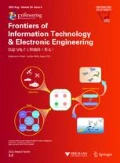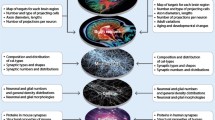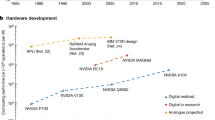Abstract
A powerful platform of digital brain is proposed using crowd wisdom for brain research, based on the computational artificial intelligence model of synthesis reasoning and multi-source analogical generating. The design of the platform aims to make it a comprehensive brain database, a brain phantom generator, a brain knowledge base, and an intelligent assistant for research on neurological and psychiatric diseases and brain development. Using big data, crowd wisdom, and high performance computers may significantly enhance the capability of the platform. Preliminary achievements along this track are reported.
Similar content being viewed by others
References
Amunts K, Schleicher A, Bürgel U, et al., 1999. Broca’s region revisited: cytoarchitecture and intersubject variability. J Comp Neurol, 412(2):319–341. https://doi.org/10.1002/(SICI)1096-9861(19990920)412:2<319::AID-CNE10>3.0.CO;2-7
Arnold JB, Liow JS, Schaper KA, et al., 2001. Qualitative and quantitative evaluation of six algorithms for correcting intensity nonuniformity effects. NeuroImage, 13(5):931–943. https://doi.org/10.1006/nimg.2001.0756
Aubert-Broche B, Evans AC, Collins L, 2006. A new improved version of the realistic digital brain phantom. NeuroImage, 32(1):138–145. https://doi.org/10.1016/j.neuroimage.2006.03.052
Baars BJ, Gage NM, 2010. Cognition, Brain, and Consciousness: Introduction to Cognitive Neuroscience (2nd Ed.). Elsevier, p.591–616. https://doi.org/10.1016/B978-0-12-375070-9.00021-8
Bansal R, Xu D, Peterson BS, 2005. Eigen function based coregistration of diffusion tensor images to anatomical magnetic resonance images. Proc Int Soc Magn Reson Med, 13:2332.
Bansal R, Staib LH, Xu DR, et al., 2007. Statistical analyses of brain surfaces using gaussian random fields on 2-D manifolds. IEEE Trans Med Imag, 26(1):46–57. https://doi.org/10.1109/TMI.2006.884187
Bansal R, Staib LH, Laine AF, et al., 2012. Anatomical brain images alone can accurately diagnose chronic neuropsy chiatric illnesses. PloS ONE, 7(12):e50698. https://doi.org/10.1371/journal.pone.0050698
Bansal R, Hao XJ, Liu F, et al., 2013. The effects of changing water content, relaxation times, and tissue contrast on tissue segmentation and measures of cortical anatomy in MR images. Magn Reson Imag, 31(10):1709–1730. https://doi.org/10.1016/j.mri.2013.07.017
Bastin ME, 1999. Correction of eddy current-induced artefacts in diffusion tensor imaging using iterative crosscorrelation. Magn Reson Imag, 17(7):1011–1024. https://doi.org/10.1016/S0730-725X(99)00026-0
Bastin ME, 2001. On the use of the FLAIR technique to improve the correction of eddy current induced artefacts in MR diffusion tensor imaging. Magn Reson Imag, 19(7): 937–950. https://doi.org/10.1016/S0730-725X(01)00427-1
Bastin ME, Armitage PA, 2000. On the use of water phantom images to calibrate and correct eddy current induced artefacts in MR diffusion tensor imaging. Magn Reson Imag, 18(6):681–687. https://doi.org/10.1016/S0730-725X(00)00158-2
Belliveau JW, Kennedy DNJr, McKinstry RC, et al., 1991. Functional mapping of the human visual cortex by magnetic resonance imaging. Science, 254(5032):716–719. https://doi.org/10.1126/science.1948051
Bohland JW, Bokil H, Allen CB, et al., 2009. The brain atlas concordance problem: quantitative comparison of anatomical parcellations. PLoS ONE, 4(9):e7200. https://doi.org/10.1371/journal.pone.0007200
Bradley MM, Sabatinelli D, Lang PJ, et al., 2003. Activation of the visual cortex in motivated attention. Behav Neurosci, 117(2):369–380. https://doi.org/10.1037/0735-7044.117.2.369
Brown RW, Cheng YCN, Haacke EM, et al., 2014. Magnetic Resonance Imaging: Physical Principles and Sequence Design (2nd Ed.). Wiley Blackwell, New York. https://doi.org/10.1002/9781118633953
Davatzikos C, 1996a. Nonlinear registration of brain images using deformable models. Proc Workshop on Mathematical Methods in Biomedical Image Analysis, p.94–103. https://doi.org/10.1109/MMBIA.1996.534061
Davatzikos C, 1996b. Spatial normalization of 3D brain images using deformable models. J Comput Assist Tomogr, 20(4):656–665. https://doi.org/10.1097/00004728-199607000-00031
Davatzikos C, 1997. Spatial transformation and registration of brain images using elastically deformable models. Comput Vis Image Underst, 66(2):207–222. https://doi.org/10.1006/cviu.1997.0605
Davatzikos C, Genc A, Xu DR, et al., 2001. Voxel-based morphometry using the RAVENS maps: methods and validation using simulated longitudinal atrophy. NeuroImage, 14(6):1361–1369. https://doi.org/10.1006/nimg.2001.0937
DeYoe EA, Carman GJ, Bandettini P, et al., 1996. Mapping striate and extrastriate visual areas in human cerebral cortex. PNAS, 93(6):2382–2386. https://doi.org/10.1073/pnas.93.6.2382
Dubin M, Weissman M, Xu DR, et al., 2012. Identification of a circuit-based endophenotype for familial depression. Psych Res Neuroimag, 201(3):175–181. https://doi.org/10.1016/j.pscychresns.2011.11.007
Evans AC, 2006. The NIH MRI study of normal brain development. NeuroImage, 30(1):184–202. https://doi.org/10.1016/j.neuroimage.2005.09.068
Fagiolo G, Waldman A, Hajnal JV, 2008. A simple procedure to improve FMRIb software library brain extraction tool performance. Br J Radiol, 81(963):250–251. https://doi.org/10.1259/bjr/12956156
Fan LY, 2013. Development of Artifact-Free Imaging System and fMRI Research Paradigm for Creative Thinking in an MR-Compatible Environment. MS Thesis, East China Normal University, Shanghai, China (in Chinese).
Fan LY, Fan XF, Luo WC, et al., 2014. An explorative fMRI study of human creative thinking using: a specially designed iCAD system. Acta Psychol Sin, 46(4):427–436 (in Chinese). https://doi.org/10.3724/SP.J.1041.2014.00427
Hagmann P, Cammoun L, Gigandet X, et al., 2010. MR connectomics: principles and challenges. J Neurosci Methods, 194(1):34–45. https://doi.org/10.1016/j.jneumeth.2010.01.014
Hagoort P, 2005. On broca, brain, and binding: a new framework. Trends Cogn Sci, 9(9):416–423. https://doi.org/10.1016/j.tics.2005.07.004
Hao XJ, Xu DR, Bansal R, et al., 2013. Multimodal magnetic resonance imaging: the coordinated use of multiple, mutually informative probes to understand brain structure and function. Human Brain Map, 34(2):253–271. https://doi.org/10.1002/hbm.21440
Haselgrove JC, Moore JR, 1996. Correction for distortion of echo-planar images used to calculate the apparent diffusion coefficient. Magn Reson Med, 36(6):960–964. https://doi.org/10.1002/mrm.1910360620
Hsu JL, Leemans A, Bai CH, et al., 2008. Gender differences and age-related white matter changes of the human brain: a diffusion tensor imaging study. NeuroImage, 39(2):566–577. https://doi.org/10.1016/j.neuroimage.2007.09.017
Huster RJ, Westerhausen R, Kreuder F, et al., 2009. Hemispheric and gender related differences in the Midcingulum bundle: a DTI study. Human Brain Map, 30(2):383–391. https://doi.org/10.1002/hbm.20509
Jack CR Jr, Bernstein MA, Fox NC, et al., 2008. The Alzheimer’s disease neuroimaging initiative (ADNI): MRI methods. J Magn Reson Imag, 27(4):685–691. https://doi.org/10.1002/jmri.21049
Jiang YW, Liu F, Fan MX, et al., 2017. Deducing magnetic resonance neuroimages based on knowledge from samples. Comput Med Imag Graph, 62:1–14. https://doi.org/10.1016/j.compmedimag.2017.07.005
Kanungo T, Mount DM, Netanyahu NS, et al., 2002. An efficient k-means clustering algorithm: analysis and implementation. IEEE Trans Patt Anal Mach Intell, 24(7):881–892. https://doi.org/10.1109/TPAMI.2002.1017616
Liu F, Peterson B, Duan Y, et al., 2006. Fast spin echo for T2 quantification at 3T. Proc 14th Scientific Meeting of the International Society for Magnetic Resonance in Medicine, p.2404.
Liu F, Garland M, Duan YS, et al., 2008. Study of the development of fetal baboon brain using magnetic resonance imaging at 3 Tesla. NeuroImage, 40(1):148–159. https://doi.org/10.1016/j.neuroimage.2007.11.021
Liu F, Garland M, Duan YS, et al., 2010. Techniques for in utero, longitudinal MRI of fetal brain development in baboons at 3 T. Methods, 50(3):147–156. https://doi.org/10.1016/j.ymeth.2009.03.019
Liu W, Liu XZ, Yang G, et al., 2012a. Improving the correction of eddy current-induced distortion in diffusion-weighted images by excluding signals from the cerebral spinal fluid. Comput Med Imag Graph, 36(7):542–551. https://doi.org/10.1016/j.compmedimag.2012.06.004
Liu W, Liu XZ, He XF, et al., 2012b. Spatial normalization of diffusion tensor images with voxel-wise reconstruction of the diffusion gradient direction. Proc 2nd Int Conf on Multimodal Brain Image Analysis, p.134–146. https://doi.org/10.1007/978-3-642-33530-3_11
Liu XZ, Yuan ZM, Zhu JM, et al., 2013. Medical image registration by combining global and local information: a chain-type diffeomorphic demons algorithm. Phys Med Biol, 58(23):8359–8378. https://doi.org/10.1088/0031-9155/58/23/8359
Lorenzi M, Ayache N, Frisoni G, et al., 2010. 4D registration of serial brain’s MR images: a robust measure of changes applied to Alzheimer’s disease. Miccai Workshop on Spatio-Temporal Image Analysis for Longitudinal and Time-Series Image Data.
Lynch G, 1979. Representations in the brain. Science, 204(4394):762. https://doi.org/10.1126/science.204.4394.762
Maguire EA, 2001. Neuroimaging, memory and the human hippocampus. Rev Neurol, 157(8-9 Pt 1):791–794.
Mak KK, Kong WY, Mak A, et al., 2013. Polymorphisms of the serotonin transporter gene and post-stroke depression: a meta-analysis. J Neurol Neurosurg Psych, 84(3):322–328. https://doi.org/10.1136/jnnp.2012-303791
Michelucci P, Dickinson JL, 2016. The power of crowds. Science, 351(6268):32–33. https://doi.org/10.1126/science.aad6499
Neeb H, Zilles K, Shah NJ, 2006. Fully-automated detection of cerebral water content changes: study of age-and genderrelated H2O patterns with quantitative MRI. NeuroImage, 29(3):910–922. https://doi.org/10.1016/j.neuroimage.2005.08.062
Ng HP, Ong SH, Foong KWC, et al., 2006. Medical image segmentation using k-means clustering and improved Watershed algorithm. IEEE Southwest Symp on Image Analysis and Interpretation, p.61–65. https://doi.org/10.1109/SSIAI.2006.1633722
Nickel M, Murphy K, Tresp V, et al., 2016. A review of relational machine learning for knowledge graphs. Proc IEEE, 104(1):11–33. https://doi.org/10.1109/JPROC.2015.2483592
Packard MG, White NM, 1991. Dissociation of hippocampus and caudate nucleus memory systems by posttraining intracerebral injection of dopamine agonists. Behav Neurosci, 105(2):295–306. https://doi.org/10.1037/0735-7044.105.2.295
Pan YH, 1996. The synthesis reasoning. Patt Recogn Artif Intell, 9(3):201–208 (in Chinese).
Pan YH, 1997. Intelligent CAD Methodology and Modeling. Science Press, Beijing, China (in Chinese).
Peterson BS, Warnera V, Bansal R, et al., 2009. Cortical thinning in persons at increased familial risk for major depression. PNAS, 106(15):6273–6278. https://doi.org/10.1073/pnas.0805311106
Plessen KJ, Grüner R, Lundervold A, et al., 2006. Reduced white matter connectivity in the corpus callosum of children with Tourette syndrome. J Child Psychol Psych, 47(10):1013–1022. https://doi.org/10.1111/j.1469-7610.2006.01639.x
Rhodes G, Brennan S, Carey S, 1987. Identification and ratings of caricatures: implications for mental representations of faces. Cogn Psychol, 19(4):473–497. https://doi.org/10.1016/0010-0285(87)90016-8
Schreibmann E, Thorndyke B, Li TF, et al., 2008. Fourdimensional image registration for image-guided radiotherapy. Int J Radiat Oncol Biol Phys, 71(2):578–586. https://doi.org/10.1016/j.ijrobp.2008.01.042
Shapiro ML, Eichenbaum H, 1999. Hippocampus as a memory map: Synaptic plasticity and memory encoding by hippocampal neurons. Hippocampus, 9(4):365–384. https://doi.org/10.1002/(SICI)1098-1063(1999)9:4<365::AID-HIPO4>3.0.CO;2-T
Shen DG, Davatzikos C, 2002. HAMMER: hierarchical attribute matching mechanism for elastic registration. IEEE Trans Med Imag, 21(11):1421–1439. https://doi.org/10.1109/TMI.2002.803111
Shen DG, Davatzikos C, 2003. Very high-resolution morphometry using mass-preserving deformations and HAMMER elastic registration. NeuroImage, 18(1):28–41. https://doi.org/10.1006/nimg.2002.1301
Shen DG, Davatzikos C, 2004. Measuring temporal morphological changes robustly in brain MR images via 4-dimensional template warping. NeuroImage, 21(4):1508–1517. https://doi.org/10.1016/j.neuroimage.2003.12.015
Shen DG, Sundar H, Xue Z, et al., 2005. Consistent estimation of cardiac motions by 4D image registration. LNCS, 3750: 902–910. https://doi.org/10.1007/11566489_111
Sowell ER, Peterson BS, Kan E, et al., 2007. Sex differences in cortical thickness mapped in 176 healthy individuals between 7 and 87 years of age. Cerebr Cort, 17(7):1550–1560. https://doi.org/10.1093/cercor/bhl066
Sowell ER, Kan E, Yoshii J, et al., 2008. Thinning of sensorimotor cortices in children with tourette syndrome. Nat Neurosci, 11(6):637–639. https://doi.org/10.1038/nn.2121
Sporns O, 2011. The human connectome: a complex network. Ann New York Acad Sci, 1224(1):109–125. https://doi.org/10.1111/j.1749-6632.2010.05888.x
Squire LR, 1992. Memory and the hippocampus: a synthesis from findings with rats, monkeys, and humans. Psychol Rev, 99(2):195–231.
Toga AW, Clark KA, Thompson PM, et al., 2012. Mapping the human connectome. Neurosurgery, 71(1):1–5. https://doi.org/10.1227/NEU.0b013e318258e9ff
van Essen DC, Smith SM, Barch DM, et al., 2013. The WU-Minn Human Connectome Project: an overview. NeuroImage, 80:62–79. https://doi.org/10.1016/j.neuroimage.2013.05.041
van Hecke W, Sijbers J, de Backer S, et al., 2009. On the construction of a ground truth framework for evaluating voxel-based diffusion tensor MRI analysis methods. NeuroImage, 46(3):692–707. https://doi.org/10.1016/j.neuroimage.2009.02.032
Wen Y, Peterson BS, Xu DR, 2013. A highly accurate, optical flow-based algorithm for nonlinear spatial normalization of diffusion tensor images. Int Joint Conf on Neural Networks, p.1–8. https://doi.org/10.1109/IJCNN.2013.6706989
Xu DR, 1995. A Study of Analogical Generation of Image in Designing, in Computer Science. PhD Thesis, Zhejiang University, Hangzhou, China, p.120 (in Chinese).
Xu DR, 1998. Automated analogical design of newspaper page layout. Chin J Comput, 21(12):1066–1073 (in Chinese). https://doi.org/10.3321/j.issn:0254-4164.1998.12.002
Xu DR, Pan YH, 1995. Generation-oriented analogy reasoning. Sci China, 38(9):150–167
Xu DR, Mori S, Shen DG, et al., 2003. Spatial normalization of diffusion tensor fields. Magn Reson Med, 50(1):175–182. https://doi.org/10.1002/mrm.10489
Xu DR, Hao XJ, Bansal R, et al., 2008. Seamless warping of diffusion tensor fields. IEEE Trans Med Imag, 27(3):285–299. https://doi.org/10.1109/TMI.2007.901428
Zhuang JC, Hrabe J, Kangarlu A, et al., 2006. Correction of eddy-current distortions in diffusion tensor images using the known directions and strengths of diffusion gradients. J Magn Reson Imag, 24(5):1188–1193. https://doi.org/10.1002/jmri.20727
Acknowledgments
Special thanks to Professor Yunhe Pan for the inspiring meeting and discussion in 2014, which initialized this work.
Author information
Authors and Affiliations
Corresponding author
Additional information
Project supported by the National Key R&D Program of China (No. 2017YFC1308502) and the National Natural Science Foundation of China (No. 81471734)
Rights and permissions
About this article
Cite this article
Xu, D., Dai, F. & Lu, Y. A platform of digital brain using crowd power. Frontiers Inf Technol Electronic Eng 19, 78–90 (2018). https://doi.org/10.1631/FITEE.1700800
Received:
Revised:
Published:
Issue Date:
DOI: https://doi.org/10.1631/FITEE.1700800
Keywords
- Artificial intelligence
- Digital brain
- Synthesis reasoning
- Multi-source analogical generating
- Crowd wisdom
- Deducing
- Neuroimaging




